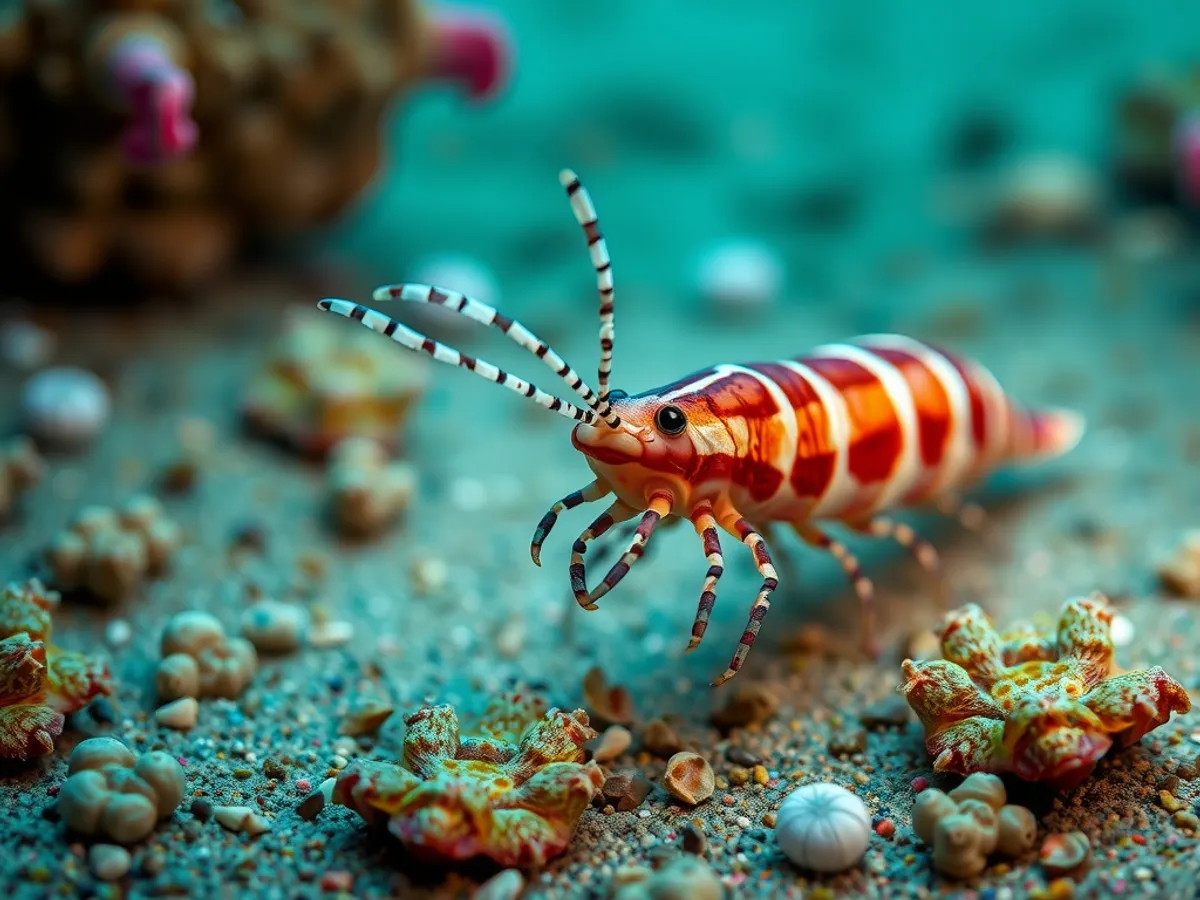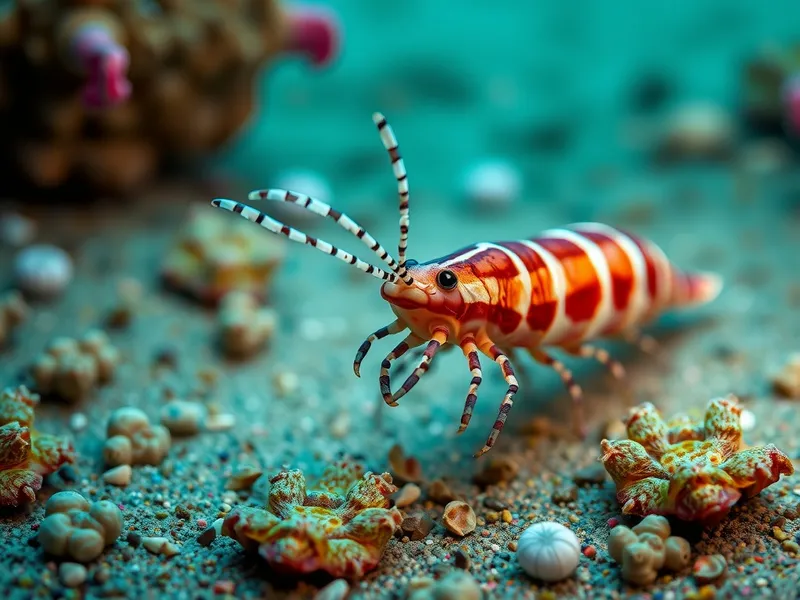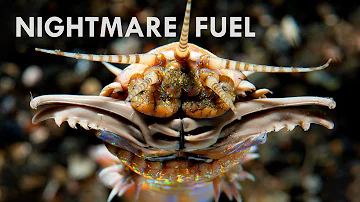
Bobbit Worm
Eunice aphroditois

Meet the Bobbit Worm
The Bobbit worm is a large predatory polychaete annelid found in the warm oceans of the Indo-Pacific region. It is famous for its long, segmented body that can reach up to 3 meters in length and its five antennae, which it uses to sense prey. The Bobbit worm buries itself in the seafloor substrate, leaving only its jaws exposed, and ambushes unsuspecting fish and invertebrates with lightning-fast strikes. Its powerful jaws can slice prey in half, and it injects toxins to immobilize its victims. Despite its fearsome reputation, the Bobbit worm plays an important role in maintaining healthy marine ecosystems.
Classification
Invertebrate
Habitat
Tropical ocean seafloor
Diet
Carnivore
Lifespan
3-5 years
Conservation
Least Concern
Weight
Up to 400 grams
📖Fascinating Facts
Impressive Size
Bobbit worms can grow over 3 meters (10 feet) long, making them one of the longest polychaete worms in the world.
Ambush Predator
Bobbit worms lie in wait beneath the sand, using their antennae to detect prey before striking with lightning speed.
Formidable Jaws
Their scissor-like jaws can snap shut instantly, sometimes slicing prey in half or inflicting serious wounds.
📋Detailed Description
Eunice aphroditois, commonly known as the Bobbit worm, is a strikingly large polychaete annelid inhabiting tropical and subtropical marine environments. Its elongated, segmented body can range from under 10 cm to an extraordinary 3 meters in length, though individuals over 1 meter are rare. The worm's body is covered in iridescent, chitinous setae (bristles) that can display a spectrum of colors, including metallic hues of bronze, purple, and green, serving both as camouflage and warning. The anterior end features five highly sensitive antennae, which detect vibrations and chemical cues from potential prey. Its eversible pharynx houses a pair of powerful, scissor-like mandibles capable of rapid extension and inflicting severe wounds. Bobbit worms are entirely benthic, spending most of their lives concealed in mucus-lined burrows within sandy or muddy substrates, often near coral reefs. They are solitary and highly territorial, rarely tolerating conspecifics in close proximity. Despite their fearsome predatory reputation, they are also opportunistic scavengers, feeding on carrion when available. Reproduction is sexual, with external fertilization; gametes are released into the water column, and larvae are planktonic before settling to the benthos. The species exhibits remarkable regenerative abilities, able to regrow lost segments, which is advantageous given the risks of predation and injury in their environment.
💡 Did you know?
The Bobbit worm is named after a notorious 1990s incident, but there is no evidence the worm actually bites off appendages.
🔬Research & Sources
Wikipedia Summary
Eunice aphroditois is a benthic bristle worm of warm marine waters. It lives mainly in the Atlantic Ocean, but can also be found in the Indo-Pacific. It ranges in length from less than 10 cm (4 in) to 3 m (10 ft). Its exoskeleton displays a wide range of colors, from black to purple and more. This species is an ambush predator; it hunts by burrowing its whole body in soft sediment on the ocean floor and waiting until its antennae detect prey. It then strikes with its sharp mandibles. It may also be found among coral reefs.
Last Modified: 4/22/2025
🎭Behavior & Social Structure
Bobbit worms are primarily nocturnal ambush predators, remaining buried in the substrate with only their antennae and jaws exposed. They rely on mechanoreception and chemoreception to detect passing prey, such as small fish, crustaceans, and cephalopods. When prey comes within range, the worm rapidly extends its pharynx and snaps its jaws shut, often with enough force to bisect small fish. After capturing prey, the worm retracts into its burrow to consume the meal, sometimes injecting a toxin to subdue struggling victims. Bobbit worms are solitary and aggressively defend their burrows from intruders, using their jaws as both offensive and defensive weapons. They exhibit site fidelity, often remaining in the same burrow for months or even years. Daily activity peaks at dusk and during the night, with minimal movement during daylight hours to avoid predators.
👶Reproduction & Life Cycle
Eunice aphroditois is dioecious, with separate male and female individuals. Spawning is believed to be synchronized with lunar cycles, particularly during warmer months, though precise timing varies by region. During spawning, adults release eggs and sperm into the water column for external fertilization. The fertilized eggs develop into trochophore larvae, which are planktonic and drift with ocean currents for several weeks before metamorphosing and settling to the benthic substrate. There is no parental care; survival of offspring depends on dispersal and successful settlement. Sexual maturity is reached at approximately 1–2 years, depending on environmental conditions and food availability.
🛡️Adaptations & Survival
The Bobbit worm's most notable adaptation is its highly specialized ambush predation strategy, facilitated by its rapid, extendable pharynx and robust, serrated mandibles. Its iridescent, segmented body provides both camouflage and potential warning coloration against predators. The five antennae are highly sensitive to both chemical and mechanical stimuli, allowing detection of prey in low-visibility environments. The worm's ability to regenerate lost body segments is a significant evolutionary advantage, enabling recovery from predation attempts or accidental injury. Its burrowing behavior not only aids in ambush hunting but also provides protection from predators and environmental fluctuations. Additionally, the secretion of mucus to line its burrow stabilizes the structure and deters some parasites and pathogens.
🎨Cultural Significance
The Bobbit worm has gained notoriety in popular culture due to its dramatic hunting behavior and formidable appearance. Its common name is a reference to a sensationalized human incident in the 1990s, though this has no biological basis. In some regions, the worm is featured in marine aquarium exhibits as an example of extreme predatory adaptation, but it has no known role in traditional folklore or as a food source. The species has become a subject of fascination among divers and underwater photographers, contributing to marine ecotourism and public interest in marine biodiversity.
🔬Recent Research & Discoveries
Recent studies have focused on the biomechanics of the Bobbit worm's predatory strike, revealing that its jaws can close in less than a millisecond, making it one of the fastest predatory responses among annelids. Molecular phylogenetic research has clarified its relationships within the Eunicidae family, and ongoing work is examining the ecological impact of its predation on reef fish populations. There is growing interest in the chemical composition of its venom and mucus, with potential biomedical applications. Observational studies using remote cameras have provided new insights into its nocturnal activity patterns and burrow construction behaviors.
🎥Wildlife Videos

Bobbit Worms: Pure Nightmare Fuel
----------- SOCIAL MEDIA https://www.instagram.com/animalogicshow/ https://twitter.com/animalogicshow ...
Animalogic

Bobbit Worms Are Straight Out of a Horror Movie
A hidden predator lurks in the ocean floor. It can strike down prey so fast it's gone in an instant. This terrifying creature has inspired ...
Crazy Creatures

The Fear of the Beaches: Bobbit Worm! ⛱😱🪱
This is the ocean's most dangerous worm! And it's practically immortal! While it's hard to spot on the sand's surface, lurking below ...
Nature Revealed

BOBBIT WORM ─ Deadliest Creature in The Ocean!
Meet the BOBBIT WORM ─ THE THING OF NIGHTMARES Fast speed, probes that mimic light to ambush ...
BEASTERS

Dangerous Animals The Bobbit Worm
sources for video https://www.youtube.com/watch?v=aMorvRRbZ5E&t=47s https://www.youtube.com/watch?v=refnOdW49rw ...
Planet Earth Unleashed

Scary Bobbit worm eating and amazing facts || Bobbit worm documentary || Bobbit worm hunting
Quick facts about Bobbit worm, under water creature. If you like my vedios you can support my channel here: ...
Unique Animals
🌍Habitat Information
The Bobbit Worm typically inhabits Tropical ocean seafloor environments. Bobbit Worms have adapted to their environments with specialized features and behaviors.
Primary Habitat:
Tropical ocean seafloor
More detailed habitat information will be available soon.
🛡️Conservation Status
The Bobbit Worm is currently classified as Least Concern. Conservation efforts are crucial for preserving this species for future generations.
Common Threats:
- 🏠Habitat loss and fragmentation
- 🌡️Climate change impacts
- 🎯Hunting and poaching
- 🏭Human-wildlife conflict
⚠️Threats & Conservation Challenges
Currently, Eunice aphroditois faces few natural predators due to its cryptic lifestyle and formidable defenses, though larger fish and crustaceans may prey on juveniles. Human threats are minimal, as the species is not commercially harvested and is classified as Least Concern by conservation authorities. However, habitat degradation—particularly the destruction of coral reefs and sedimentation from coastal development—may impact local populations. Collection for the aquarium trade is rare but has been documented. Climate change, with its associated impacts on ocean temperature and chemistry, could pose future challenges by altering prey availability and habitat structure. Population trends are generally stable, but localized declines may occur where habitats are disturbed.
🔬Scientific Classification
Scientific Name
Eunice aphroditois
Classification Hierarchy
🔍 About Taxonomic Classification
Taxonomic classification is a hierarchical system used by scientists to classify and organize living organisms based on shared characteristics and evolutionary relationships.
The system moves from broad categories (Kingdom) to increasingly specific ones, with each animal's scientific name typically consisting of its Genus and species.
📝Community Notes
Share your observations and insights about the Bobbit Worm with our community of wildlife enthusiasts.
Join Our Community
Sign in to share your observations and connect with fellow wildlife enthusiasts.
Sign In to ContributeNo community notes yet
Be the first to share your observations about the Bobbit Worm!
Explore Bobbit Worm
Select a tab above to learn more about this amazing animal.
📸Photo Gallery
No photos available for this animal yet.
🌟Discover More Wildlife
Continue your journey of discovery with more fascinating animals from our database
